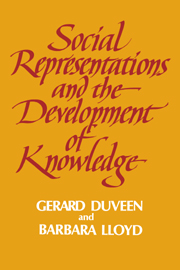Book contents
- Frontmatter
- Contents
- List of figures
- List of tables
- List of contributors
- Acknowledgements
- 1 Introduction
- 2 The underlife of the nursery school: young children's social representations of adult rules
- 3 A semiotic analysis of the development of social representations of gender
- 4 Children's representations of social relations
- 5 Social representations of childhood: an implicit theory of development
- 6 What is in an image? The structure of mothers' images of the child and their influence on conversational styles
- 7 The acquisition of reflexive social emotions: the transmission and reproduction of social control through joint action
- 8 From social cognition to social representations in the study of intelligence
- 9 Prototypes of the psychologist and professionalisation: diverging social representations of a developmental process
- 10 Social psychology and developmental psychology: extending the conversation
- Author index
- Subject index
6 - What is in an image? The structure of mothers' images of the child and their influence on conversational styles
Published online by Cambridge University Press: 08 March 2010
- Frontmatter
- Contents
- List of figures
- List of tables
- List of contributors
- Acknowledgements
- 1 Introduction
- 2 The underlife of the nursery school: young children's social representations of adult rules
- 3 A semiotic analysis of the development of social representations of gender
- 4 Children's representations of social relations
- 5 Social representations of childhood: an implicit theory of development
- 6 What is in an image? The structure of mothers' images of the child and their influence on conversational styles
- 7 The acquisition of reflexive social emotions: the transmission and reproduction of social control through joint action
- 8 From social cognition to social representations in the study of intelligence
- 9 Prototypes of the psychologist and professionalisation: diverging social representations of a developmental process
- 10 Social psychology and developmental psychology: extending the conversation
- Author index
- Subject index
Summary
Introduction
We frequently resort to the use of vivid images, aware as we are of their explicative power: we search our minds for them to explain a concept or idea which, because of its abstract nature, may not be readily understood. We are also aware that employing an image not only results in a simplification of information but also makes the concept familiar by relating it to our listener's knowledge of everyday life. Everyday language and knowledge are particularly rich in images precisely because they merge and accomplish this transformation from concept to image.
The notion of the use of images, as Abric (1987) has recently pointed out, has a long history in the psychological literature, though in terms of a perceptual model in which the image is seen as a reflection of the outside world with a clear separation between the subject and the object. Our interpretation of the image derives from the concept of representation, and assumes a constitutive relation between subject and object. In these terms the image is not a mere reflection of the object as such, but a product of complex relations, either real or imaginary, objective or symbolic, which the subject projects into a specific object.
From a cognitive point of view a representation may be assimilated within a mental framework which Zajonc (1968) described as a form of interdependence between cognitive elements which affects motivation, attitudes, emotion and behaviour. The notion of social representation, as Abric (1987) observes, involves a much more complex process, a total reconstruction of reality in its psychological, social and ideological aspects.
- Type
- Chapter
- Information
- Social Representations and the Development of Knowledge , pp. 91 - 106Publisher: Cambridge University PressPrint publication year: 1990
- 6
- Cited by

